Text



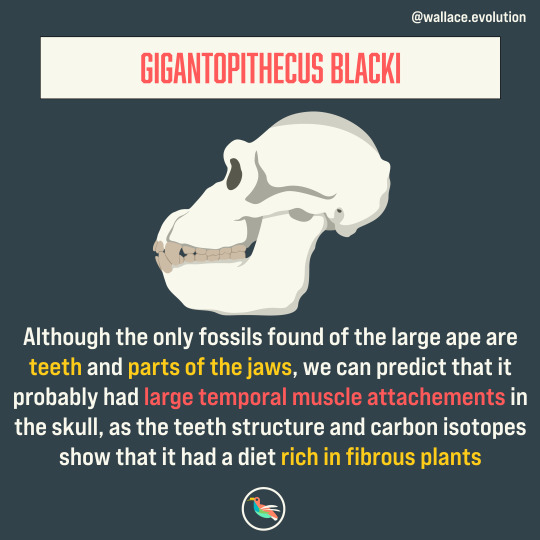
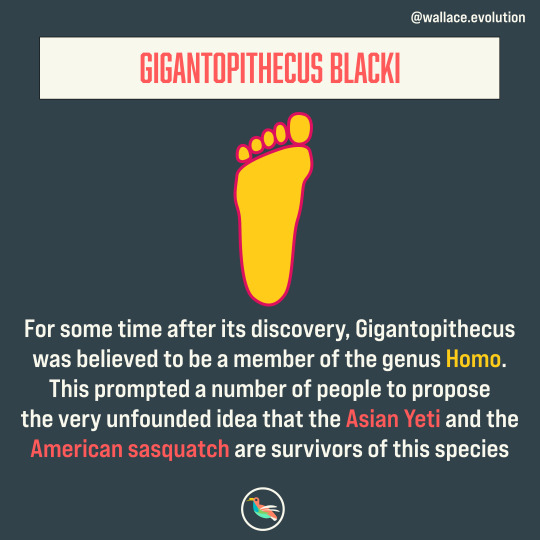
While very little is known of the look of this giant ape in life, paleontologists were able to determine a number of facts about its lifestyle based on analysis of the main fossils found: Teeth. The presence of traces of plants in these teeth, and their flat dense-enamel, shows that like gorillas, Gigantopithecus had a diet rich in foliage and fibrous plants.
It's probable size, diet and the fact that it was closely related to modern Orangutans, were the basis for the reconstruction I made for this post.
#fossil#fossils#theory of evolution#evolution#education#information#illustration#infographic#art#design#darwin#charles darwin#wallace#evidence#science#evol#giant#monkey#orangutans#teeth#china#asia
54 notes
·
View notes
Text

Hi! It has been a while, but here it is, back again: Evidence for Evolution.
The fact that whales descended from mammals that were adapted to land is supported by a number of findings: The common ancestor of all mammals was terrestrial, vestigial organs AND atavistic limbs, a rich and extensive fossil record that shows a gradual land-to-sea body plan change, but today's evidence is more direct than that.
The fossil record of cetaceans and their ancestors is rich in skulls. This allowed paleontologists to scan the structure of the inner ear of these animals, determining the detailed anatomy of the vestibule (the part of the inner ear responsible for balance in land animals). The findings? The further we go back in time, the bigger the vestibule is.
The gradual decrease of size over time that scientists were able to document, supports that these extinct ancestors were indeed adapting slowly but surely to a life in water, where the sense of balance is not only useless but limiting to the swimming efficiency.
edit: corrected a mistake, thanks @felawnie :)
#paleontology#paleo#ancestor#mammal#water#sea#anatomy#fossil#evidence#science#evol#illustration#infographic#art#design#darwin#charles darwin#wallace#theory of evolution#evolution
52 notes
·
View notes
Text
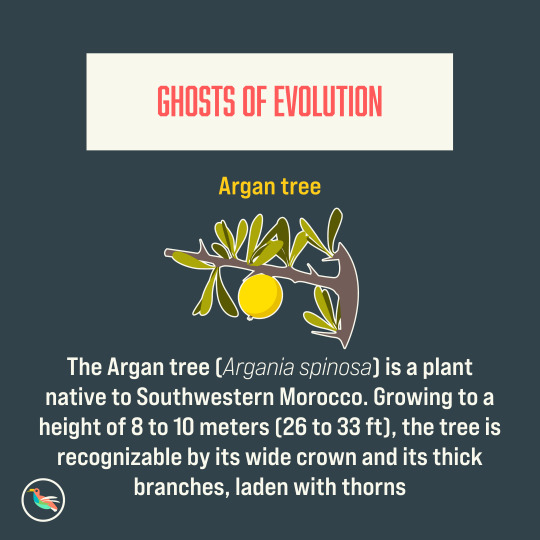


Hey guys,
Today's episode concerns a tree that you are probably all familiar with : The Argan tree.
This tree, also known as Argania spinosa, is a plant native to Southwestern Morocco, and more precisely to the Sous valley. Other than humans who use it for Argan oil production, the only other predator of the Argan tree are domestic goats that climb them, as the tree is too high for all other animals in the region.
In addition to the fact that goats were introduced to the region by humans only in the last few millennia, the goats seem undeterred by the thorns that blanket the branches of this tree.
This raises a simple question : Who was the original predator of the tree?
#Morocco#arganoil#argantree#trees#plants#plant#tree#evidence#science#evol#extinct#goats#goat#illustration#infographic#art#design#darwin#charles darwin#evolution#education#information#wallace#theory of evolution
57 notes
·
View notes
Text

Again, a great example of speciation.
During the late 19th century, scientists and farmers from Scotland and Germany were able to create a new genus, composed of 3 species.
While this group of plants was the result of human deliberate actions, and a lot of in-lab work, it demonstrates nonetheless a very fundamental fact : A new genus can appear from older ones.
This example shows very clearly that a genus is not an unbreakable barrier that stayed immutable since the creation. And while human action was involved in its creation, nothing stops us from assuming that under similar selection pressures from nature, new species groups branched off regularly during the history of the earth.
#art#science#speciation#evolution#wallace#theory of evolution#education#information#illustration#infographic#design#darwin#charles darwin#evidence#plants#genus#wheat#rye
23 notes
·
View notes
Text



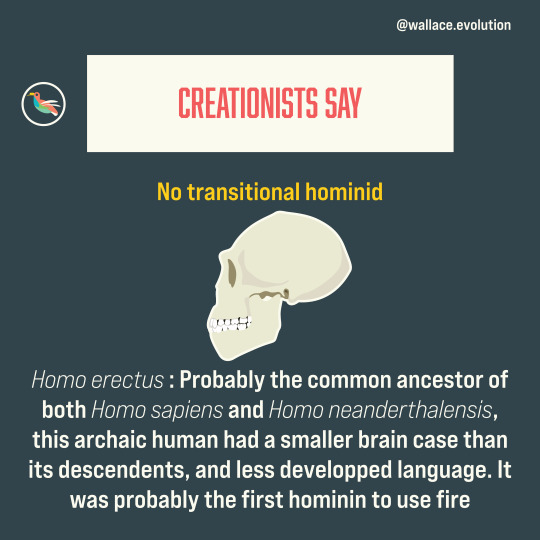

"There is no evidence that humans descended from apes." This claim made by creationists reveals that a large portion of them opposes evolution not on the basis of careful and extensive research, but purely out of principle.
This fact results in many creationists repeating the same information, without even trying to verify its veracity.
So in today's post, we will answer the question: Is there evidence?
There is indeed, and in the form that most creationist claim not to exist: Transitional fossils.
#science#human#fossil#skull#homo sapiens#wallace#theory of evolution#evolution#education#information#illustration#infographic#art#design#darwin#charles darwin#evol#evidence
111 notes
·
View notes
Text

What better evidence of evolution than how domestic animals changed since humans started breeding them.
Although the domestic pig and the wild boar are the same species, they are anatomically and behaviorally totally different.
This difference within the same species shows that strong enough selection (in this case, human need), is enough to create a strong difference in various species.
#education#information#illustration#infographic#art#design#darwin#charles darwin#evidence#science#evol#pig#artificial#wallace#theory of evolution#evolution
82 notes
·
View notes
Note
Sometimes I feel hopeless for living in a religious world that condemns knowledge yet lives at the expense of science. I love science more than anything in this world, I want to be a scientist but what discourages me is that scientists in my country basically work under abusive circumstances. They don’t have holidays, don’t have weekends, don’t earn much and work 12-16 hours a day. There’s nothing that I love more than science but I’m not sure I wanna follow this path if I’ll suffer so much. Should I give up before starting? Please, I need a light here :(
Honestly? I was in your exact situation a few years ago. I loved animals ever since I was kid and I dreamt of working with them for as long as I could remember. But as I grew up I realized that I still needed to make a living hahaha.
So, instead of becoming an ingineer for example and doing something I didn’t love, I decided to pursue medical school (biology was another passion) and to focus my love for science on science communication (aka this blog).
I think in your case you should just ask yourself a simple question. What do you value most? Your quality of life? Or advance in science? To me the answer was obvious, and you should find your own.
Also try to reach out to professionals in your field of interest and keep in mind that immigration is always an option. It’s true that the internet is full of information but nothing beats asking people with experience. They might have a solution you didn’t even think of.
18 notes
·
View notes
Text

The central tenet of the theory of evolution as it is today, is that all life on earth descended from a common ancestor. Going by this logic, every organism is related to each other. In a way, all life belongs to one giant family tree. By this logic, the claim "Humans and chicken share a common ancestor, and thus are related" is a reasonable one.
But is there any direct evidence for this? Actually...yes. If we are asked for the biggest differences between us and chickens, laying eggs would probably come on top. Since humans give birth, it is a fact that they don't produce the building blocks of said eggs. Then, why does the human genome contain bits and pieces of such genes that code for these building blocks? The most reasonable explanation is that humans inherited these genes from an egg-laying ancestor, that also happened to be an ancestor of chickens. Otherwise, specially-created humans have no need for such broken genes.
A question might be asked : Why are these genes broken? All genes are subject to mutations at a fairly constant rate. A fact of physics and chemistry. When a gene is vital, then any mutation that makes it lose its function will be selected against. If a chicken has a mutation of the VIT2 gene, it won't be able to make the yolk. Without it, no reproduction. So the gene kept its function, because all members who had a negative (said "inactivating" or "loss-of-function") mutation, had no descends. Now imagine a human or an ape having an inactivating mutation in the VIT2 gene? Nothing happens. No natural selection stops this mutation from spreading, because the gene isn't needed, and we get a pseudogene or gene fragments.
#mutation#biochemistry#biology#dna#poultry#birds#genes#eggs#egg#bird#gene#illustration#infographic#art#design#evidence#science#evol#theory of evolution#evolution
143 notes
·
View notes
Note
I remember hearing someone say "every back is a bad back due to our f*cked up transition into bipedals" and I don't really know what to look up to confirm or deny this. Could you maybe explain? Sorry if this is a confusing or dumb question
I am sorry is this answer is lazy, but I don't think I can give a better explaination than this article in Science.
That being said, tl;dr : Our spine's vertebrate bones and disks weren't made to be on top of each other. They are very unbalanced and loose, making our muscles strain too much, and they have a high risk of slipping (like in disk herniation). They also weren't made to bear vertical weight (explains why vertebral fractures are often the first manifestation of osteoporosis). If you still have trouble understanding, ask again and I will do my best to give you more detailed sources
69 notes
·
View notes
Note
That's some interesting coloration you used for your Haast's eagle reconstruction. It reminds me more of a passerine, like a corvid or starling, than a raptor. What was the inspiration?
The coloration was an artistic take on the description made by Sir George Grey (who described it as a black-and-white bird, with a red crest and yellow wing tips). He allegedly met the bird queqtion, or what possibly is the bird. That being said, I left out few details for the sake of aesthetics (like the yellow wing tips). I used Ravens and Crows as inspiration of the shades of black, and the Northern Cardinal for the red.
14 notes
·
View notes
Note
As someone who knows as much about evolution as you, I hope it's okay to ask this question because I've been searching for answers my whole life with no avail. Did humans (any species) used to have tails? I've heard so much bullshit over this topic for years, and as someone who actually WAS born with a tail (yes I still have it) I'd really appreciate your knowledge on this subject if you have any
The short answer is no. No human species (as in no species of the genus Homo) has ever had a tail, so your tail isn't inherited from a human ancestor. The long answer is, no but actually yes. The homo genus split from other apes between 13 and 4 million years ago (long time because the split was complicated). Because of this, the tail was actually lost way before this happened, when apes split from monkeys, around 25 million years ago. So humans didn't LOSE their tail, but actually never inherited one from their ancestor. Your tail has pretty deep origin (little disclaimer : The loss of the tail isn't very well documented in the fossil record, so a lot of data is lacking for a really clear picture, and a lot of what we know is deduced from indirect evidence)
38 notes
·
View notes
Text
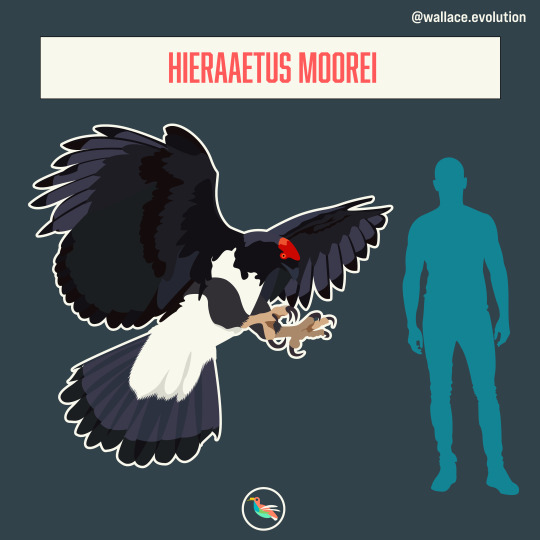
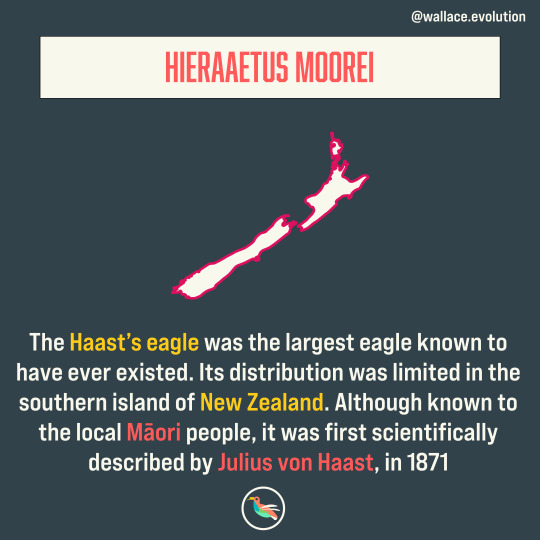
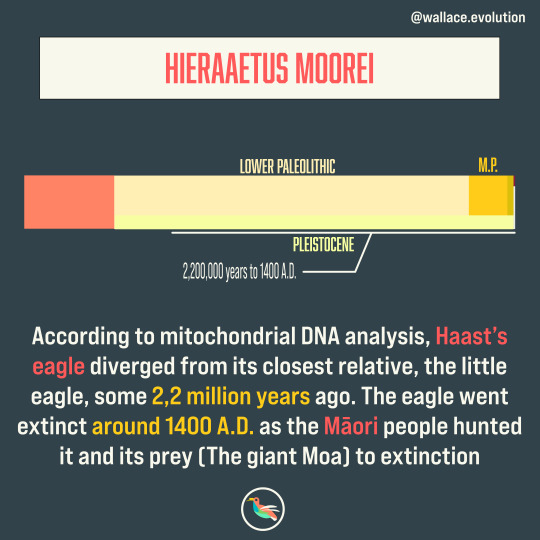
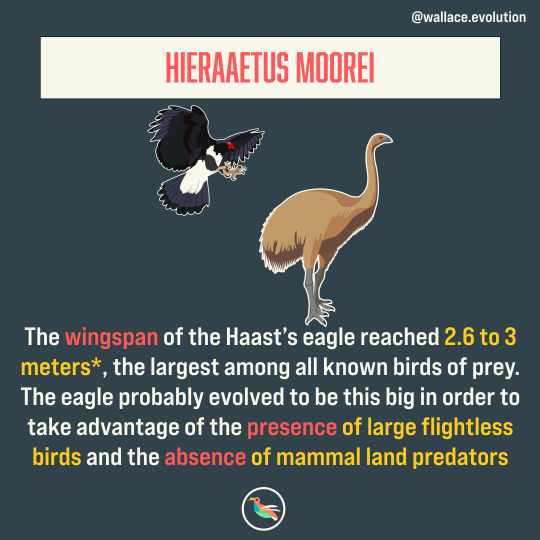

The Haast's eagle, the largest eagle known to have ever existed, is a fascinating example of different animal groups filling the same ecological niche. As we saw on an old "Ghosts of Evolution" post, Moas in New Zealand filled the "big grazer" niche that is usually filled by mammals like buffalos and deer. For the Haast's eagle, it filled the competitor niche, that of tigers and lions. Thanks to the presence of large prey on the island, and the absence of competition from carnivorans, it grew to large sizes unhindered.
I hope you will learn new things from this post.
*2.6 to 3 meters : 8.5 to 9.8 feet.
#eagle#paleo#paleoart#paleontology#theory of evolution#evolution#education#information#illustration#infographic#art#design#darwin#charles darwin#science#evol#maori#pouakai#dna#extinct
1K notes
·
View notes
Text


I’m late to the trend but here it is.
Aquilolamna milarcae, also known as the eagle shark is a new species of sharks discovered in Mexico in 2012, and only described this year by the paleontologist Margarito González González. It was a shark that swam in the Mexican waters in the late Cretaceous, about 93 million years ago.
What’s fascinating about this shark species is two points. First, its unusual anatomy which points to a way of swimming that is quite peculiar : it probably glided through the water using its tail as a propellor. Second, it probably was a filter feeder, like today’s Whale shark and the Basking shark. Meaning it scooped whatever creature gets inside its mouth.
This shark is a great example of convergent evolution as its body plan is close to that of today’s Manta rays.
#eagle shark#paleo#paleoart#paleontology#fossil#theory of evolution#evolution#education#information#illustration#infographic#art#design#darwin#charles darwin#evidence#science#evol#whale#shark#wallace
710 notes
·
View notes
Text

If fish are the ancestors of all tetrapods, then shouldn't we expect to find a number of animals half-fish half-tetrapod in the fossil record, with an overlap of gills, limbs, and lungs?
Well, that's indeed what we find.
Many of you might have heard of Tiktaalik, but did you know that there is a number of transitional fossils that trace a detailed story of transition from the seas to land?
Today we will meet one of them : Acanthostega.
#wallace#theory of evolution#evolution#education#information#illustration#infographic#art#design#darwin#charles darwin#evidence#science#evol#fish#tetrapods#fossils#fossil#fossil records#sea
272 notes
·
View notes
Text

While the fact that black people are black as a means to protect against the sun's harmful UV rays, or the fact that Scandinavians are taller on average, or that people in Tibet have more efficient oxygen transportation, can be used as arguments for evolution, many creationists could argue that we didn't see those adaptations happen.
Maybe all of Adam's children had one or many of those traits. Maybe God miraculously gave those traits to humans.
But what about traits that we observed in humans after we mastered genetics, linking them to a precise detectable mutation?
Do humans still evolve? The short answer is : Yes
#wallace#theoryofevolution#evolution#education#information#illustration#infographic#art#design#darwin#charlesdarwin#evidence#science#evol#sexworkers#sexworker#2000s#hiv#human#humans#aids#walking aids
83 notes
·
View notes
Note
On the topic of the chimps thing, what happened to the "primitive" members of so many modern animal lineages alive today? Why are there no more primitive walking whales like Pakicetus? Or primitive proboscideans like Moeritherium? Or primitive multi-toed horses like Eohippus? (Though I guess you CAN use monotremes and marsupials as examples of primitive mammals alive today, even if they're as equally derived in their own way as placentals are.)
The answer to this question is 2 parts:
1- Species have an average "lifespan" so to speak. For example, mammal species exist on average for 1-2 million years before going extinct (source : https://pubmed.ncbi.nlm.nih.gov/12348876/)
2- Species only exist so long as the environment they are adapted to exists. They can either go extinct by dying out (That's the case for Moeritherium), without leaving a descendence. Or by branching into one or more new species that are more adapted to the new environment (as Eohippus gave rise to Orohippus. The most probable scenario is this : Global cooling of the planet => less forests / more grasslands in North America => A small population of Eohippus evolves grinding teeth more adapted to grass => this new population thrives and diverges to become Orohippus, the old-fashioned Eohippus phenotype dies out for lack of forests. New species in, ancestral species out)
That being said, it's not always the case. Both the Eschscholzii and the Klauberi salamanders descend from a common ancestor : The Oregonensis salamander. The twist? All 3 of them are alive and extant today. Instead of a change of environment driving the evolution of Oregonensis, it was the migration of 2 distincy population + natural barrier separation that cause the speciation.
I hope this answered the question
35 notes
·
View notes
Note
Do you know how many species go extinct per year nowadays?
It varies by year, but it's estimated to be around 200-2000 species per year (insects included)
17 notes
·
View notes